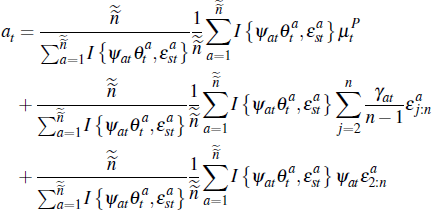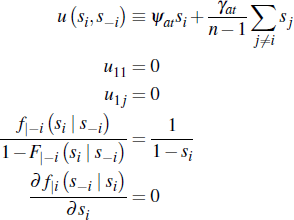RDP 2014-09: Predicting Dwelling Prices with Consideration of the Sales Mechanism Appendix D: Seller Reserve Prices
September 2014 – ISSN 1320-7229 (Print), ISSN 1448-5109 (Online)
- Download the Paper 822KB
D.1 Non-optimal Seller Reserve Prices
Consider the case of a non-optimal seller reserve in the English auction. Specifically, there is a single buyer remaining in the auction, and the seller compares the highest outstanding bid with their own (private) reservation value:
where  is again drawn uniformly on
is again drawn uniformly on  . The seller accepts the highest bid made
if
. The seller accepts the highest bid made
if  ,
and the sale occurs. If
,
and the sale occurs. If  the seller rejects the bid and the dwelling
is passed in. In the case that the final bid is accepted, the price is given
by:
the seller rejects the bid and the dwelling
is passed in. In the case that the final bid is accepted, the price is given
by:
To be clear, seller bids are non-optimal in this case for two reasons. First, as discussed in Milgrom and Weber (1982), sellers choosing a reserve that is not state-contingent and that maximises revenue will, in general, want to disclose the reserve price before the auction commences. Second, as discussed in Lopomo (2001), an optimal seller reserve that conditions on the highest bid (is state-contingent) and that maximises expected revenue, will in general not be the same as the seller's own estimate of the value of the dwelling. We will consider the second case further below. Proceeding under the assumption of a non-optimal reserve price, and assuming for simplicity that ψat + γat = 1, we note that in an individual auction the price still converges to:
as the number of buyers grows large. Whether an individual auction will be successful
(with infinitely many buyers) or not will therefore depend on whether  ,
in which case the auction will be successful, or
,
in which case the auction will be successful, or  , in which case it
will not.
, in which case it
will not.
With a non-optimal seller reserve price, the average auction price, is given by:
where we are now explicitly accounting for the fact that there are auctions where
the dwelling is passed in, and so  is the total number of auctions, including both successful and unsuccessful auctions.
is the total number of auctions, including both successful and unsuccessful auctions.
 is an indicator function such that:
is an indicator function such that:
Taking the limit as both the total number of buyers and total number of auctions become large, one can verify that:
and so, in principle, the average auction price depends on the distribution of the upper bound of buyer valuations, the distribution of seller valuations (which is assumed to be independent of the former), and the distribution of weights that buyers place on their own signals.
Nevertheless, as discussed in the main text, for a valid VECM approximation to exist,
the selection effect term,  ,
must be approximately constant. If this were not the case, then a VECM with
finite lags and serially uncorrelated residuals could not be used to represent
the underlying data-generating process. From this perspective, including
a non-optimal seller reserve value does not change the main results discussed
in the paper. For example, consider the case in which
,
must be approximately constant. If this were not the case, then a VECM with
finite lags and serially uncorrelated residuals could not be used to represent
the underlying data-generating process. From this perspective, including
a non-optimal seller reserve value does not change the main results discussed
in the paper. For example, consider the case in which  and is constant across
all auctions. In this case,
and is constant across
all auctions. In this case,  but
but  is not constant.
This is an example of how there can be time variation in the auction clearance
rate that is autocorrelated and due to the role of sellers. However, auction
prices themselves are not influenced by sellers values nor are they autocorrelated.
is not constant.
This is an example of how there can be time variation in the auction clearance
rate that is autocorrelated and due to the role of sellers. However, auction
prices themselves are not influenced by sellers values nor are they autocorrelated.
D.2 Optimal Seller Reserve Prices
The previous case considered a non-optimal seller reserve price. An alternative case of interest is when sellers set their reserve price optimally. Lopomo (2001, Proposition 1) derives the optimal state-contingent seller reserve price for a seller who maximises their expected revenue when selling an object through an English auction, and where buyer values are affiliated as defined by Milgrom and Weber (1982). We use the word state-contingent here to capture the idea that the seller observes the auction process, and then determines an optimal seller reserve price that can be affected through a single seller (vendor) bid made at the point in which there is only one buyer remaining in the auction. The remaining buyer can then choose to match that bid and the dwelling is sold, or exit the auction and the dwelling is passed in.
Following Lopomo, let the seller face n risk-neutral buyers who participate in an English auction. Define
N ≡ {1, …,n}. Each buyer, i ∈
N, observes a private signal of the value of the dwelling,  ,
drawn jointly with the other n − 1 signals
,
drawn jointly with the other n − 1 signals  from a symmetric
distribution with density f that is strictly positive on its support
S ≡ [0, 1]n. The restriction on the support is
less general than assumed in the previous appendices, but can matched by
assuming that
from a symmetric
distribution with density f that is strictly positive on its support
S ≡ [0, 1]n. The restriction on the support is
less general than assumed in the previous appendices, but can matched by
assuming that  and that
and that  is continuously distributed
on the support [−½,½]. To conserve notation, we will
drop the a superscript and the t subscript, but it should
be noted that the following arguments apply to a single auction of dwelling
a at time t.
is continuously distributed
on the support [−½,½]. To conserve notation, we will
drop the a superscript and the t subscript, but it should
be noted that the following arguments apply to a single auction of dwelling
a at time t.
Signals are assumed to be affiliated:
And buyers have a valuation function:
where Si ≡ [0,1] and S−i ≡ [0,1]n−1 and the valuation function v is strictly increasing in its first argument, and weakly increasing and symmetric in its last n−1 arguments such that u (si, s−i ≡ ui(s1,…,sn) for each i ∈ N. The overall pay-off function of buyer i is:
where Qi denotes the probability that buyer i is awarded the dwelling and Mi denotes the expected payment to the seller. Restated here for convenience, Lopomo (2001) proves the following proposition:
Proposition 1. Given the following assumptions:
A1: Fix any (s1, …,sN) ∈ S, pick two elements si and sj, and let s−ij ∈ [0,1]n−2 denote the vector containing the remaining n−2 signals. Then, si > sj implies u (si,sj,s−ij ≥ u (sj,si,s−ij)
A2: 
A3: 
A4: All conditional hazard ratios  are non-decreasing in si,
where
are non-decreasing in si,
where  and
and  denote the distribution
and density functions of si conditional on
denote the distribution
and density functions of si conditional on 
A5: The derivative  exists for all s ∈ S
exists for all s ∈ S
Then, the optimal seller reserve price, set after n−1 buyers drop out, is given by:
where the function t0 (s−i) must satisfy:
Proof. See Lopomo (2001).
Moreover, Lopomo (2001) shows that the seller's expected revenue is maximised among all posterior-implementable and individually rational outcome functions.
A few comments are worth noting at this point. First, Lopomo's assumptions are relevant to the linear example of affiliated values with independent signals that we use. To see this, note that:
which satisfies assumptions A1 to A5. Further, assuming  and
and  is uniformly distributed on [−½, ½], ensures that each signal, s,
has a continuous distribution with support [0,1], consistent with Lopomo
(2001).
is uniformly distributed on [−½, ½], ensures that each signal, s,
has a continuous distribution with support [0,1], consistent with Lopomo
(2001).
Second, the seller is assumed to be able to set their reserve optimally, after observing the auction proceed until the point at which there is a single buyer remaining. In effect, the seller acts as a buyer in the final stage of the auction competing with the one remaining buyer. In practice this could be implemented through a single vendor bid made at the point at which there is one buyer left in the auction. A single vendor bid is allowed in a standard auction format in NSW and Victoria.
Third, and importantly for our results, the seller's optimal reserve is a function only of the signals of n − 1 buyers who have already exited the auction. This is important, because it suggests that the optimal reserve in effect is determined by buyers' information.
Fourth, solving for the optimal reserve explicitly, in our linear example of affiliated values, we have (applying Proposition 1):
The remaining buyer (with highest signal) will accept this reserve (match the vendor bid) if:
or will otherwise exit the auction.
Accordingly, the effect of introducing an optimal seller reserve is to change the equilibrium price of the auction. The intuition for why this occurs is that the seller knows with positive probability that the remaining buyer is willing to pay more than the price at which the second-last buyer dropped out (recall that the second-last buyer does not observe the signal of the final remaining buyer). For this reason, the seller optimises between the expected gain from placing a higher vendor bid that the remaining buyer may be willing to pay if their signal is high enough, and the expected cost that the vendor bid is too high and the remaining buyer exits the auction (and so the gains from trade are foregone).
In terms of the implications for an individual auction price, with an optimal seller
reserve, it follows that the equilibrium price when the auction clears  ,
and there are many buyers, converges to
,
and there are many buyers, converges to
Recall, to be strictly compatible with Lopomo we have assumed  and
and  .
Thus, with an optimal seller reserve price, the average auction price still
converges to the common component in all prices up to a scaling factor.
.
Thus, with an optimal seller reserve price, the average auction price still
converges to the common component in all prices up to a scaling factor.
Finally, although we have presented this argument abstracting from a positive seller
outside option and have not accounted for the fact that not all dwellings
sell when determining average prices, these too can be incorporated. Specifically,
there is a significant selection effect that depends on the term  .
However, again our empirical work suggests that this selection effect is
unlikely to be an important driver of changes in auction prices.
.
However, again our empirical work suggests that this selection effect is
unlikely to be an important driver of changes in auction prices.














